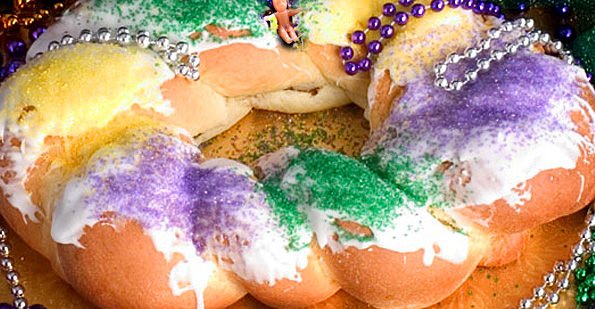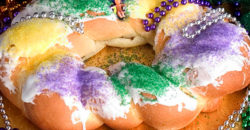King Cake
A round, braided cake consumed during the Carnival season across Louisiana, especially in New Orleans.

Wikimedia Commons
King Cake, 2008.
King cake, in its most common and basic form, is a round, braided, sweet cinnamon pastry or bread consumed during the Carnival season across Louisiana, especially in New Orleans.
Much of Carnival culture’s essential framework, including the king cake, can be traced to Medieval Europe. On January 6—known on the Catholic calendar as Twelfth Night, Epiphany, or the evening the three kings visited the infant Jesus Christ—Catholics feasted on almond-stuffed pastries to celebrate the beginning of the pre-Lenten, or Carnival, season. In France the Epiphany cake became known as a galette des rois. In German-speaking countries: Dreikönigskuchen. In Spanish-speaking countries: roscón de reyes. And in the UK: Twelfth Cake.
Each culture, just as would become the norm in Louisiana, filled their cakes with a tiny prize: a bean, a piece of candy, a coin or charm, or a little porcelain doll representing the Christ child. The celebrant who received the slice that contained the prize was named “king.”
King cake culture likely existed in New Orleans as soon as professional and home bakers could get their hands on sugar, flour, and butter. But in 1871 the Twelfth Night Revelers Carnival krewe hosted a debutante ball with a cake containing a bean made of gold and several made of silver. A debutante named Emma Butler received the gold bean, becoming Mardi Gras’s first queen. The event started a king cake boom in the city, with bakeries specializing in French-style galette des rois-type cakes. Twelfth Night parties, from here on out, could not proceed without a cake.
By the 1930s the king cake had developed into the ubiquitous round shape and braided form we now know. It would also become democratized, with department stores and grocery stores selling industrialized, cheaper, sugarier king cakes, decorated in the now-traditional Mardi Gras colors of purple, green, and gold. King cakes thus became associated not just with Twelfth Night but with the entire Carnival season. By the 1960s plastic king cake babies, just like the plastic beads thrown during parades, became the norm. These days king cake culture dictates that whoever “gets the baby,” or cuts into a slice that has the baby hidden inside, is responsible for providing the next king cake.
According to the city’s tourism bureau, more than five hundred thousand king cakes are sold each year in the greater New Orleans area during the Carnival season, with another fifty thousand shipped out-of-state. Open since 1959 Haydel’s Bakery bakes more than seventy-five thousand king cakes annually.
Today king cakes come in all shapes, sizes, and flavors, sweet and savory. King cake has also transcended the cake form to become a local flavor. There is king cake ice cream, king cake soda, king cake–flavored vodka, and countless other king cake–flavored sweets.
But despite the regional ubiquity of the cake, New Orleanians especially eschew eating king cakes outside of Carnival season, despite constant efforts by grocery stores and bakeries to foist Halloween, Christmas, and Saints-themed king cakes on shoppers. Eating king cake out of season, legend says, brings the curse of rain on Mardi Gras Day.
